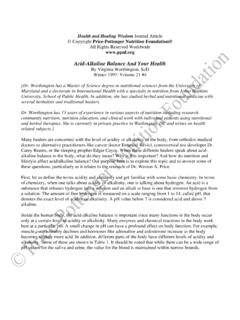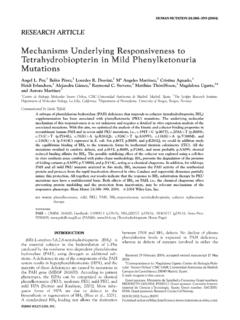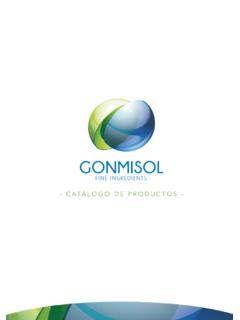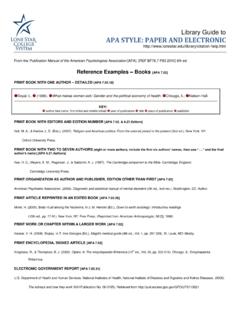Transcription of Communications - BIRI
1 Introduction Hepatitis B is a potentially life-threatening liver infection caused by the hepatitis B virus (HBV) and a major global health problem and the most serious type of viral hepatitis. According to the statistics from World Health Organization, an estimated two billion people have been infected with the HBV worldwide, and more than 240 million have chronic liver infections. About 600,000 people die every year due to the acute or chronic consequences of hepatitis B. 1 Hepatitis B is endemic in China and other parts of Asia. 1 Th ere are about 93 million patients with chronic HBV infection of whom 20 million present with chronic hepatitis B (CHB) in China. 2 However, the pathogenesis of hepatitis is still poorly understood.
2 To date, oxidative stress has been found to play an important role in the pathogenesis of hepatitis. 3,4 Th e reactive oxygen species (ROS) and the ROS induced lipid peroxidation (LPO) involve in the pathology of viral hepatitis and have been regarded as a major cause of liver injury. 3 5 Studies have confi rmed the redox imbalance in the CHB patients. 6 In 2007, Ohsawa et al. found that hydrogen acts as a therapeutic antioxidant by selectively reducing cytotoxic oxygen radicals including hydroxyl radical ( OH) and peroxynitrite (ONOO ). 7 In previous studies, inhalation of hydrogen and intraperitoneal and oral administration of hydrogen-rich water have been found to exert protective eff ects in numerous animal models including ischemia/reperfusion injury and infl ammation in many organs.
3 7 9 However, the protective eff ect of hydrogen on virus induced infl ammation including hepatitis has not been reported so far. This study aimed to investigate the effect of hydrogen-rich water on the oxidative stress (superoxide dismutase [SOD]; glutathione S transferase [GST]; xanthine oxidase [XOD]; malondialdehyde [MDA]), liver function (alanine aminotransferase [ALT]; total biliary acid [TbiL]; cholinesterase [ChE]), and HBV load in patients with CHB. Th is study may provide evidence for the clinical application of hydrogen-rich water in the treatment of CHB. Subjects and Methods Collection of subjects Th irty healthy subjects (25 males; 5 females) for routine physical examination were recruited as controls.
4 Th ey had no system diseases aff ect the important organs including heart, liver, kidney, and lung. Th e liver and kidney function was normal, and they had no viral hepatitis or were not the carriers of viral hepatitis. Th e mean age was years (range: 20 55 years). Inclusion criteria: Moderate CHB inpatients ( n = 60) were recruited from August 2010 to September 2010. Th ere were 49 males and 11 females. Th ese patients were randomly assigned into hydrogen treatment group or routine treatment group ( n = 30 per group). Th e diagnosis of CHB was based on the Guideline for Prevention and Treatment of Chronic Hepatitis B. 2 Exclusion criteria: Hepatitis A, C, D, and E, alcoholic hepatitis, drug-induced hepatitis, and autoimmune hepatitis were excluded.
5 Tumors, hematological diseases, heart diseases, hypertension, hyperthyroidism, diabetes, pregnancy, hepatic cirrhosis, and neuropsychiatric disorders were excluded. In the routine treatment group, there were 24 males and 6 females with a mean age of years; in the hydrogen treatment group, there were 25 males and 5 females with a mean age of years. Th is was a controlled, randomized, blind study. Th e whole study protocol was approved by the Ethics Committee of Forth People s Hospital of Huai an, and written informed consent was obtained before study. Effect of Hydrogen-Rich Water on Oxidative Stress, Liver Function, and Viral Load in Patients with Chronic Hepatitis B Chunxiang Xia , 1,3 , Wenwu Liu , 3, , Dongxiao Zeng , 1 , Liyao Zhu , 2 , Xiaoli Sun , 2 , and Xuejun Sun , 3 Communications 1 Center for Clinical Laboratory of Forth People s Hospital of Huai an , Jiangsu , 223002 , China ; 2 Department of Hepatology of Forth People s Hospital of Huai an , Jiangsu , 223002 , China.
6 3 Department of Diving Medicine, the Second Military Medical University , Shanghai , 200422 , China Xia CX and Liu WW contributed equally to this work . Correspondence: X. J. Sun ( ) DOI: 10 .1111/ c t s .12 0 7 6 Abstract Objective : To investigate effects of hydrogen-rich water (HRW) on oxidative stress, liver function and HBV DNA in patients with chronic hepatitis B (CHB). Methods : Sixty patients with CHB were randomly assigned into routine treatment group or hydrogen treatment group in which patients received routine treatment alone or additional oral HRW (1200 1800 mL/day, twice daily), respectively, for 6 consecutive weeks. Serum oxidative stress, liver function, and HBV DNA level were detected before and after treatment.
7 Thirty healthy subjects served as controls. Results : When compared with controls, oxidative stress was obvious in CHB patients, and the liver function also signifi cantly impaired. After treatment, the oxidative stress remained unchanged in routine treatment group, but markedly improved in hydrogen treatment group. The liver function was improved signifi cantly and the HBV DNA reduced markedly after corresponding treatments. Although a signifi cant difference was noted in the oxidative stress between two groups after treatment, the liver function and HBV DNA level were comparable after treatment and both had improved tendencies. Conclusion : HRW signifi cantly attenuates oxidative stress in CHB patients, but further study with long-term treatment is required to confi rm the effect of HRW on liver function and HBV DNA level.
8 Clin Trans Sci 2013; Volume 6: 372 375 Keywords: hydrogen-rich water , oxidative stress , liver function , chronic hepatitis B , viral load 372 VOLUME 6 ISSUE 6 ISSUE et al. Effect of Hydrogen-Rich Water on Chronic Hepatitis B T r e a t m e n t In the routine treatment group, patients received routine treatment, and hydrogen-free water was administered to patients at designed time points. In the hydrogen treatment group, besides routine treatment, hydrogen-rich water was orally given thrice daily (8 9 AM; 14 15 PM; 18 19 PM) for consecutive 6 weeks (1,200 1,800 mL daily). 9 All subjects were not treated with other antioxidants within 1 week before study. Th e fasting venous blood (4 mL) was collected in the morning before and aft er 6-week treatment.
9 Following centrifugation at 3,000 rpm for 5 minutes, the serum was collected and stored at 70 C for further use. Preparation of hydrogen-rich water Hydrogen-rich water was produced by placing a metallic magnesium stick into drinking water (Mg + 2H 2 O Mg(OH) 2 + H 2 ); final hydrogen concentration: mM). The magnesium stick contained pure metallic magnesium and natural stones in a polypropylene and ceramic container. 9,10 D e t e c t i o n s Th e XOD method was used to detect the SOD activity, chemical colorimetric detection was done to detect the GST and XOD, and thiobarbituric acid colorimetric analysis was employed for detection of MDA. Reagents were purchased from the Nanjing Jiancheng Biotech Co.
10 , Ltd (Nanjing, China), and detections were done according to the manufacturer s instructions. Real-time fl uorescence quantitative PCR Real-time fl uorescence quantitative PCR was done to measure the HBV DNA (20120114; Da an Gene Biotech Co., Ltd, Guangzhou, China) with a thermal cycler (ABI 5700; Applied Biosystems, Foster City, CA, USA). Th e lower limit of detection was 10 3 copies/mL. Detection of liver function ALT, TbiL, and ChM were measured with an automatic biochemical analyzer (TBA-120R; Toshiba, Tokyo, Japan), and reagents (No: 12125) were purchased from Whiteman Biotech Co., Ltd. (Nanjing, China). Detection was done according to manufacturer s instructions.








